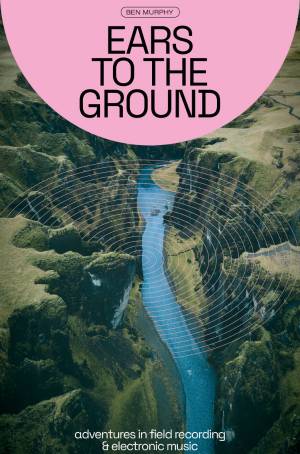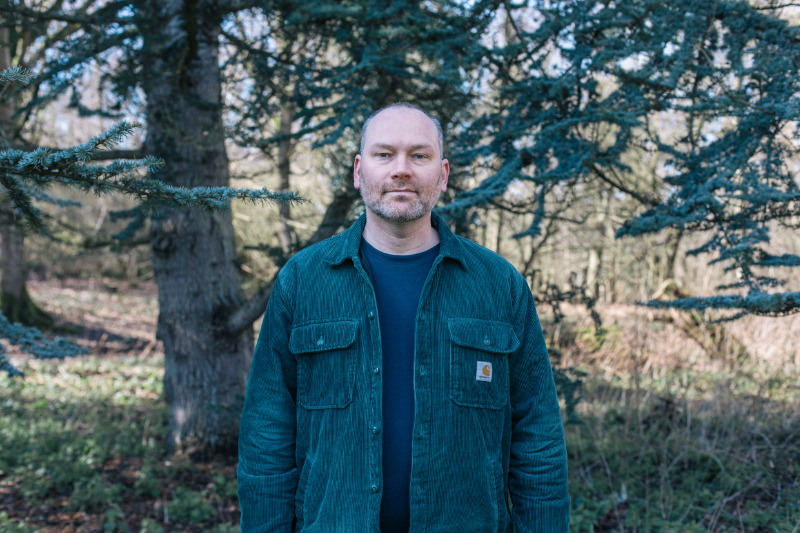We’re publishing the new book by esteemed music journalist Ben Murphy on 10 May. Ears to the Ground: Adventures in Field Recording & Electronic Music explores environments in which found sounds have been recorded by artists, taking the reader on a journey through sites like remote bird colonies, neolithic burial grounds and Antarctica. In this exclusive excerpt from the book, Ben introduces what the book is all about.
-

Ears To The Ground
£9.99 – £11.99
The waves roll in, crashing and hissing as they retreat back across the sand. The excited voices of day trippers walking along the promenade mingle with the surf. Seagulls cry and wheel in the distance, and from the mix of sounds emerges the voice of a busking folk singer, his sonorous words, sung acapella, blending with the scene. Walking down onto the beach, the sound of shoes crunching on pebbles and the louder roar of the sea is palpable.
All these things mix together to become a kind of music, a snapshot in time. Listening to my recording, made on a Zoom H1n device, I’m transported back to the seaside town of Sheringham on the Norfolk coast at the height of summer in 2023. The sensory immersion of these sounds brings back the briny tang that lingered in the air, the deep hit of the July sun. This field recording triggers the memory in an especially evocative way, in a manner that photographs or film simply can’t.
Field recordings can be powerful and evocative, especially when they’re used in electronic music. Incorporating found sounds has become an increasingly popular tool for producers, composers and musicians to add texture, context and atmosphere to their creations. It could be the cries of gannets on sea stacks off Orkney, used by Erland Cooper on his album Solan Goose, the ambient burr of a hotel lobby on Lord of the Isles’ “Don’t You Ache”, the birdsong of Iceland and Venezuela that Björk captured for her album Utopia, or the voices of bus drivers in Lagos, Nigeria that Emeka Ogboh recorded for his contemplative techno album 6°30′33.372″N 3°22′0.66″E.
All of these atmospheric recordings elevate beautiful pieces of music, transform them into something more. They can communicate culture, history, memory, a sense of humour, or political satire. They can be there for their sonic value alone, or they can hold a deeper meaning. What they offer most of all is a sense of the living, breathing world of someone else, inviting us to experience what they experience for a short while.
The medium of field recording has a long history, which is thought to have begun in 1889 with Ludwig Koch’s recording of a common shama, a type of thrush. The German-Jewish sound recordist was given a wax cylinder phonograph by his father when he was a child and made the shama recording when he was eight years old. Koch moved to Britain before World War II and became renowned for his wildlife recording ‘sound books’, made in the late thirties, but only issued for sale in 1952.
Many of the first field recordings drew from wildlife sounds or aimed to be important ethnographic documents, with recordists travelling around the world, capturing the languages or musical traditions of other countries and cultures. It was believed that these ‘sound photographs’ could offer a perfect preservation of a moment in history, but this idea was later discredited, as sound recordists came to realise that their presence, what they chose to record and omit, all had a profound influence on the recording. Ethical considerations too, such as the fact musicians were offered no credit for using their compositions, came to the fore.
Using atmospheric sounds captured on location became an important feature of what French composer Pierre Schaeffer first described in the 1940s as ‘musique concrète’. Schaeffer was one of the first to treat recordings of the outside world as material for building pieces of sound art. Setting up the Studio d’ Essai in Paris and using a library of sound effects, mixers and a disc-cutting lathe to begin his experiments in musique concrète, when he teamed up with Pierre Henry in 1949, they formed the GRMC (Groupe de Recherche de Musique Concrète), a collective and studio, and started to use some revolutionary sound techniques.
They learned to create loops from magnetic tape and pioneered the usage of several effects machines. Instead of making music as such, the two artists began to employ various recorded sounds to make their aural creations. As Jonathan Patrick points out in his appraisal of Schaeffer’s life in FACT Magazine, ‘Schaeffer’s approach… [began] with fragments of sound – field recordings of both natural and mechanical origin – which were then manipulated using studio techniques.’
Schaeffer realised that almost anything could be music, and zeroed in on the textural qualities of field recordings, which he then reversed, slowed down, or distorted to transform them. His 1948 piece “Etude Aux Chemins de Fer” created a collage of train sounds he’d recorded at Batignolles station in Paris. Though simple by today’s standards, the idea was astonishing at the time, and you can hear in the recording how Schaeffer emphasises the locomotive rhythms and accentuates the train whistles’ musical qualities.
As musique concrète became established as an experimental form of music, more composers focused on the auditory details of the world around them. As Cathy Lane and Angus Carlyle say in their book In the Field, ‘Field recording practice were further broadened and deepened through strategies associated with experimental music’s incorporation of both environmental sound and the sound worlds that those early field recording practices opened up’.
French artist Bernard Parmegiani, who started out as a technical assistant at GRMC, recorded the sounds of a bird beating its wings on the 1967 piece “Capture éphémère”, and processed and edited it to create a haunting, alien and very electronic fragment of sound art. Another famous musique concrète composer, Luc Ferrari, made Presque Rien: a long-form recording captured on the windowsill of the place he was holidaying at on the Croatian island of Korčula, with the sounds of the sea, chickens, bike bells, insects and boat motors immersing you in the atmospheric scene.
In the seventies, field recordings started to become more popular for their musical qualities. Roger Payne’s Songs of the Humpback Whale introduced the hypnotic sounds of whale song to homes, which he’d recorded on hydrophones lowered beneath the ocean waves. Jean C. Roché’s Oiseaux Du Vénézuéla, first issued in 1973, was full of the strange, vivid calls of tropical birds, and has become a classic of its kind, recently reissued with sleeve notes by David Toop. New Zealand-born American pioneer Annea Lockwood’s Glass World sought out the sonic identities of various glass objects, from wine glasses to light bulbs and jars.
It’s arguable that field recordings and electronic music as we know it were first combined by Brian Eno on albums such as Ambient 4: On Land, which purported to depict various landscapes of the UK, from Cornwall to Suffolk, but instead used recordings sourced in Honduras and Ghana for its haunting soundscapes. Reggae producer and artist Lee “Scratch” Perry would be an early adopter of field recordings too in his otherworldly dub tracks, using snippets of rain, cows mooing and babies crying to decorate his bass-heavy studio technology explorations.
In the eighties, the advent of hip-hop and sampling culture would make the idea of recording the world around you ever more appealing, and though recording devices were once very expensive and cumbersome, they’re now plentiful, cheap and accessible. It’s possible to create a decent recording on a Zoom mic, or even just your phone.
This book is not a history of field recording itself. It’s an examination of how these atmospheric sounds can be woven into electronic music and sound art in a great variety of ways. These sonic snapshots offer a window onto the landscapes, lives and experiences of musicians, and Ears to the Ground shines a light on the stories of artists around the UK, Ireland, and the wider world to show how vital field recording can be in the hands of the most talented and adventurous. It shows how they can use the medium to diarise their experiences, to interpret, understand or interrogate their worlds.
How an individual defines field recording is up to them. In this book, a field recording can mean sounds captured in nature or cities, foley (noises tailor-made to depict a specific thing, recorded in a studio setting, normally for film, radio and TV), the voices of crowds or individuals, radio interference, or even electromagnetic tones. These sounds all emanate from the world around us, and they aren’t exactly music by themselves – but presented, edited and combined with electronic sounds, they become something new. I feel like the field recordings of the artists in this book really do transport you to these places in your imagination, and certainly offer a window into the experiences of others, if only for a little while.
Perhaps field recordings, whatever form they take, remind us of our grounding in the corporeal world at a time when so many of us live and work virtually through the medium of a 2-D computer or phone screen.
I was inspired to write this book after realising that many of the magazine features I had written in recent years, for Electronic Sound, Bandcamp and DJ Magazine, involved artists who were using field recordings in various novel and surprising ways. It occurred to me that it was a growing trend, but only when I dug deeper did I realise how rich the subject was, how it was a whole world in itself.
Sound has always seemed to be less appreciated than pictorial forms of art, and though we live in an increasingly visual culture, it feels like that’s starting to change. People are becoming aware of what atmospheric recordings can tell us about the world, life, history, landscape and culture. I hope that as you read these chapters, they can take you to somewhere else in your imagination, and hear the world in a deeper way.



Add Comment